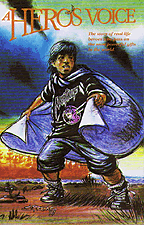Most people are visual learners, meaning they associate specific pieces of information with a particular image. Really, comic books are simply an extension of A-B-C picture books (A is for Apple, B is for Bear, C is for Calliope, etc.). Comics simply provide more information as it corresponds to provided text. For instance, when Donald Duck says “I'm gonna whip your tail feathers off” and you see a picture of Donald grimacing, rolling up his sleeve and holding a tree branch, you have a pretty good idea as to his intentions.







No comments:
Post a Comment